One of Sicily's best-kept secrets is its cuisine. Only a few Sicilian dishes, like the sweet-and-sour aubergine side dish known as caponata or the ricotta-filled cannoli, have crossed the Straits of Messina to find fame and fortune abroad.
The Greek colonists who arrived in the 8th century BC were astonished at the fertility of Sicily's volcanic soil, and Siracusa soon became the gastronomic capital of the classical world. By the 5th century BC the city had produced the first cookbook written in the West, Mithaecus’ Lost Art of Cooking, and the first school for chefs.
The Arab legacy
The Arabs brought innovative agricultural and culinary techniques and introduced crops that enriched Sicilian cooking; citrus, rice and aubergines became staples. They also made Sicilian cuisine sweet and spicy. Cane sugar was introduced, as was the Middle Eastern taste for sumptuous sweets – still a classic Sicilian trademark.
On the coast, the sea sets the agenda – it may be a classic insalata di mare (seafood with oil, lemon and herbs), pesce spada affumicato (smoked swordfish) or a dish of thumbnail-sized fried cuttlefish.
By the end of the Saracen occupation, the mould of Sicilian cooking had been set. The Normans employed Arab chefs and, until the Renaissance, Sicily exported pasta, sugar, confectionery and citrus to northern Italy. But while the Spanish brought chocolate and tomatoes from the New World and French chefs were fashionable in the 19th century, Sicilian cuisine reflected class lines.
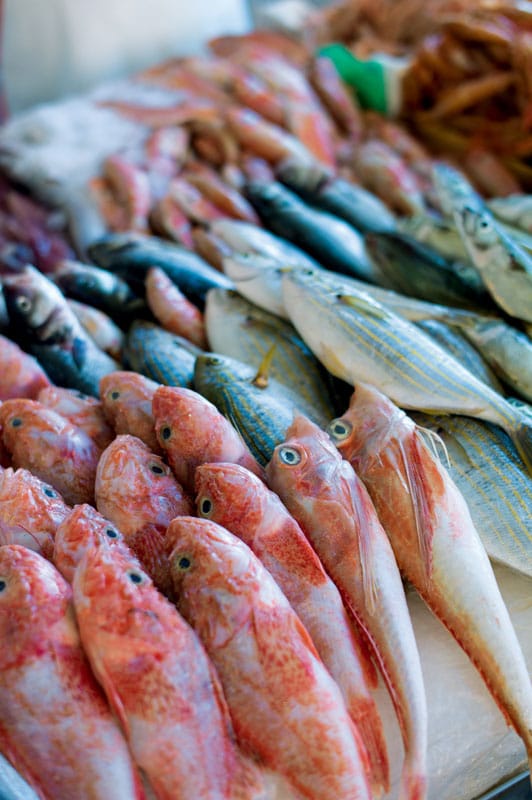
Fresh fish.
Neil Buchan-Grant/APA
The poor survived on bread and wild greens; the aristocracy lived on lavish “baronial cuisine”. It was left to the emerging borghesia to create contemporary Sicilian cooking: extravagant festive dishes, and simpler daily fare, always dedicated to exalting the extraordinary flavours of the produce.
The Sicilian menu
Restaurant starters: As antipasti, the classic dishes are sardea beccafico, sardines rolled in breadcrumbs, with a pine-nut and currant filling, baked with bay leaves, or involtinidi melanzane, stuffed aubergines in tomato sauce. In the mountain towns of the Madonie and Nebrodi, rustic antipasti include salami, cow's-milk cheeses (caciotta and caciocavallo), sheep's-milk cheeses (such as tuma) and wild mushrooms sott'olio. Sicily's finest cheese is arguably a mature Ragusano DOP, from the Monti Iblei hills near Ragusa.
Pasta: Most Sicilians feel pasta to be the proper first course. Under Arab rule, Sicily was the first place to produce dried pasta on a commercial scale. Today's best-loved dish is pasta con le melanzane, known in eastern Sicily aspasta alla Norma (after Bellini's operatic heroine). Here, tomatoes, basil, fried aubergines and a sprinkling of salted ricotta melt into a magical blend. Pasta can also be paired with fritella, a spring sauté of new peas, fava beans and tiny artichokes, or simpler combinations garnished with sautéed courgettes.
Couscous: In the Trápani area, where the Arab influence is strongest, a local version of couscous, steamed in a fish broth, supplants pasta. This is best tasted during the vibrant September Couscous Festival at San Vito lo Capo.
Fish and meat: The mountain pastures of the Madonie and Nebrodi produce exceptional lamb and pork. Beef is best stuffed and braised in tomato sauce or skewered and grilled (involtini alla siciliana). But fish and seafood predominate in Sicily, whether as a main course (pesce spada alla griglia, grilled swordfish, or tonno alla marinara, tuna with olives, capers and tomatoes) or as a starter. Western Sicily's exotic pasta con sarde was invented in the 9th century by Arab army cooks who used whatever was at hand: sardines, saffron, pine nuts, dried currants and sprigs of wild fennel. In the east, a potent sauce of anchovies and breadcrumbs is still popular (anclova e muddica). In another dish, grated smoked tuna roe mixed with olive oil and parsley is poured over spaghetti.
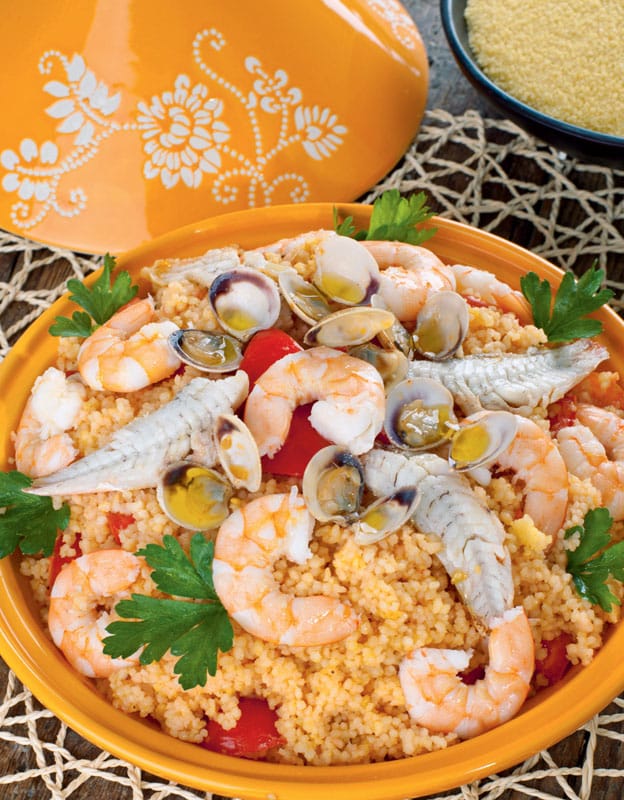
Seafood couscous.
Neil Buchan-Grant/APA
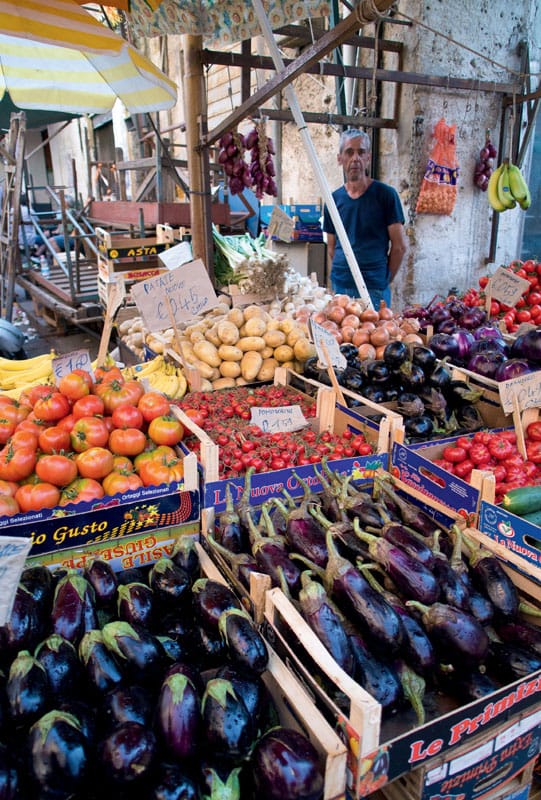
Market produce.
Neil Buchan-Grant/APA
Street Food and Markets
Sicily has a long tradition of delicious snacks, especially in Palermo and Catania: chickpea fritters (panelle), potato croquettes (crocche di patate) and fried rice balls filled with meat and peas (arancini) provide a movable feast. In the same cities, the food markets serve up gastro-porn at its most deadly: writhing octopus, slithery eels and swordfish glisten on ice blocks; beyond are barrels of olives and lemons, bunches of basil and mint, sacks of oriental spices and trays of almond-encrusted pastries. In Palermo, Antica Focacceria provides a taster of street food, as do stalls in Ballarò market and Franco u Vastiddaru (corner of Piazza Marina and Via Emanuele).
Vegetables: Melanzane alla parmigiana (aubergine baked with parmesan), a Sicilian invention, reigns supreme. Equally fine is peperonata (sweet roasted peppers), or orange and fennel salad, a legacy of the Arabs, or artichokes fried, stuffed, roasted on coals, or braised with oil, parsley and garlic. Or bright-green cauliflower cooked with anchovies, cheese, olives and red wine. The interior boasts a survivor from classical times: maccu, a purée made from dried fava or broad beans flavoured with oil and wild fennel seeds.
Sweets: Choice becomes hardest towards the end of a meal. Sicilians have had a passion for sweet pastries since Arab times, and for ice cream since the 18th century.
Surprising wines
“Sicilian wines encompass the spirit of 20 civilisations” claims wine buff Bruno Pastera. Certainly, Sicilian wines have a great pedigree, dating back to Phoenician and Greek times, but traditionally underperformed. With their prodigious amounts of sugar, they were despatched north for blending, to bump up the strength of better-known wines. More recently, there has been a full-scale return to producing serious drinking wines using native grape varieties.
Best known is Marsala, in the west of Sicily, still mistakenly synonymous with sickly-sweet liqueurs, but the best (known as Vergine or Riserva) are excellent, dry, smooth sherry-like wines.
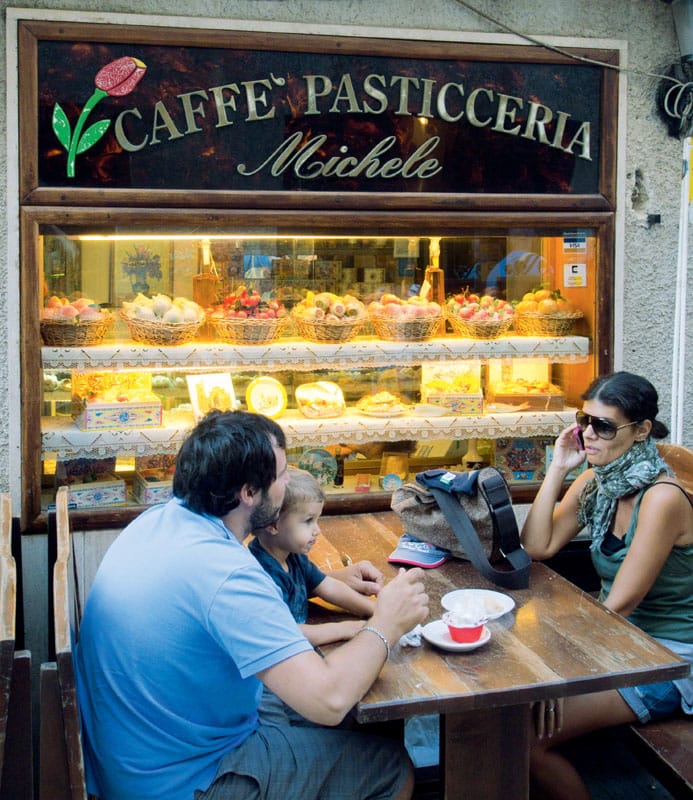
Family in front of a display of martorana, fruit-shaped marzipan sweets.
Neil Buchan-Grant/APA
Sweet Dreams are Made of This
The most famous dish of Arab descent is cassata siciliana, the spectacular, exceedingly sweet gateau filled with ricotta cream and decorated with almond paste and candied fruit. “As beautiful as cassata” is high praise in Palermo. Instead, Sicilian artisanal ice cream comes in a bewildering array of flavours, from pistachio to pine nut, marzipan to ricotta.
Then there are Sicilan pastries. From the chewy mustazzoli biscuits or the nut-and-fig-flavoured buccellato to the opulent Arab tradition of cannoli. For centuries, the chief pastry cooks were nuns: Palermo alone had more than a score of convents, each famous for a particular sweet. A few convents still sell their pastries, including an atmospheric one in Mazara. Instead, in Erice, the tradition is carried on by women who learned their trade in convent orphanages.
On All Souls’ Day, Sicilian children traditionally awake to find sugar dolls and baskets of fruit at the foot of their beds, left there by “the souls of their forefathers”. The fruit is made of marzipan, known as pasta reale or martorana, one of Sicily's most delightful culinary traditions. Nowadays, martorana is readily available all year round, and designed to resemble fruit, though visitors with more salacious tastes may be transported by other versions, the nuns’ sweet triumphs: virgins’ breasts (minni di vergini) or chancellors’ buttocks (fedde del cancelliere).
Marsala might be Sicily's most famous wine but the island abounds in award-winning wines. Veronica Bonelli, sommelier at Sicily's finest hotel, the Grand Timeo in Taormina, sums up the wine scene: “The west is better known, especially Nero d'Avola near Ragusa, and important wine-growing areas around Alcamo and Menfi, but there are also exciting wines coming from Mount Etna and the volcanic islands, such as the powerful but balanced wines made by the Hauner estate on Vulcano and Salina.”
From Marsala and Malvasia dessert wines to Bordeaux-style Mount Etna wines, from floral white to full-bodied red Nero d'Avola and cherry-coloured Cerasuolo di Vittoria – reputable estates include Gulfi, Hauner, Marchesi di Gregorio, Passopisciaro, Planeta, Regaleali and Tenuta di Donnafugata.
Even if modern Sicilian winemaking depends on merit alone, some of the best original estates were founded by the local nobility. The emblematic Regaleali estate, south of Palermo, is owned by the Conte Tasca d'Almerita, but has expanded to include estates on Mount Etna, as well as on the island of Mózia, near Marsala, and on the island of Salina. Given this range, the estate produces Rosso del Conte, a structured Nero d'Avola; Nozze d'Oro, a blend of native Inzolia and Sauvignon; dessert wines on Salina; and Etna wines based on the indigenous Nerello Mascalese varietal.
New-wave Etna wine-growers, such as the Passopisciaro estate in scenic Castiglione della Sicilia, use Nerello Mascalese to make award-winning Bordeaux-style reds. Instead, Catarratto and Inzolia are two native grape varieties that make superior whites, including dry, delicately floral wines around Alcamo. As for dessert wines, on the island of Pantelleria they favour Moscato, called Zibibbo, trained as low bushes against the incessant winds. The island of Salina has a similar tradition but with Malvasia rather than Moscato vines; the Carlo Hauner estate is recommended.
Wine resorts
These are wine estates where you can usually stay, dine, or do a cookery or wine-tasting course. Just outside Alcamo, the Sirignano Wine Resort is a delightful organic estate run by the Marchese de Gregori. Guests stay in converted farm workers’ cottages on the estate, and sample the marquess's superb wines over meals cooked by an outstanding chef.
Other fine wine resorts include La Foresteria dell'Azienda Planeta, near Menfi, and Capofaro Malvasia on Salina, owned by the aristocratic Tasca d'Almerita family, who were one of the first to offer wine and cookery courses on their estates.
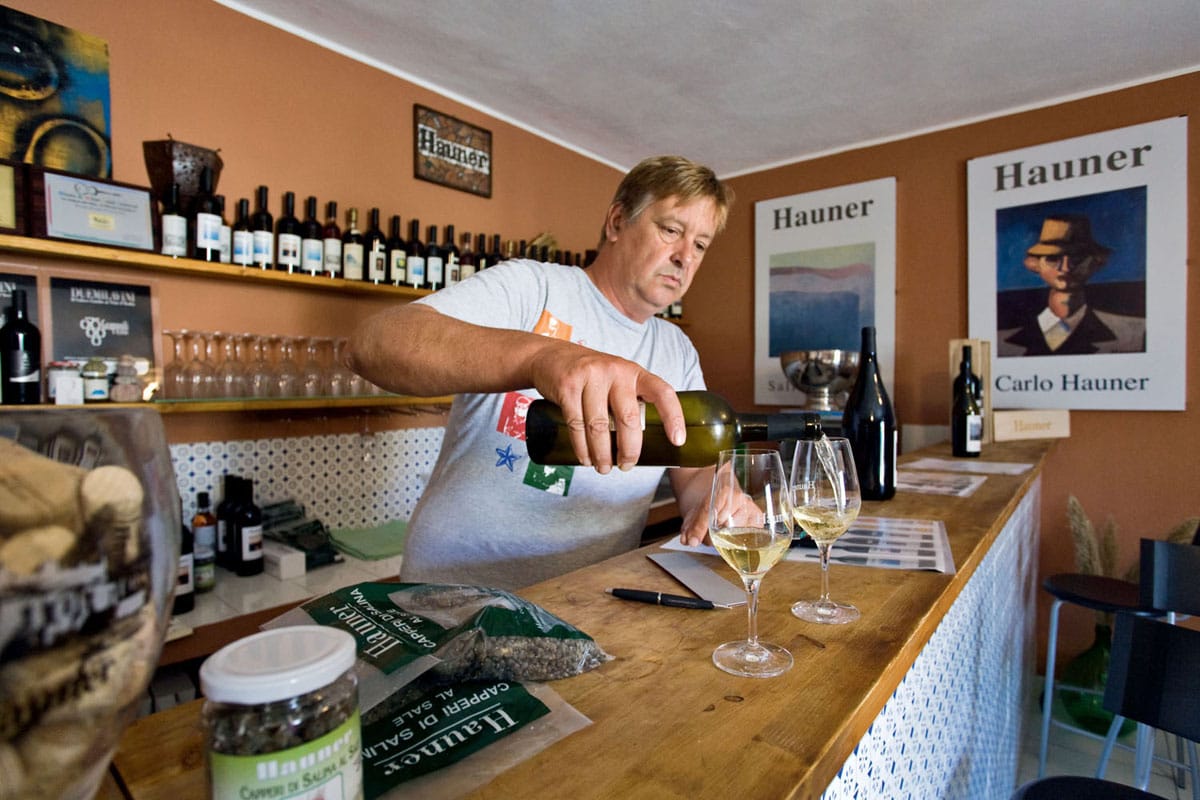
At the bar.
Neil Buchan-Grant/APA
The Marsala Merchants
Marsala, produced around the town for which it is named, was created by 18th-century English merchants as an alternative to port. By 1773, John Woodhouse, originally a soap merchant, had found a way of both improving the taste of the wine and making it last longer. The fortified wine soon found favour with Nelson's fleet, with sailors at sea rewarded with a glass at sunset. Merchant Benjamin Ingham opened a rival winery in 1806, followed by Vincenzo Florio in 1833. Marsala, made by strengthening a base wine with grape brandy and ageing the result, rivals top sherries, Madeiras and ports. Marsala's seafront warehouses make good stops for wine-tasting.